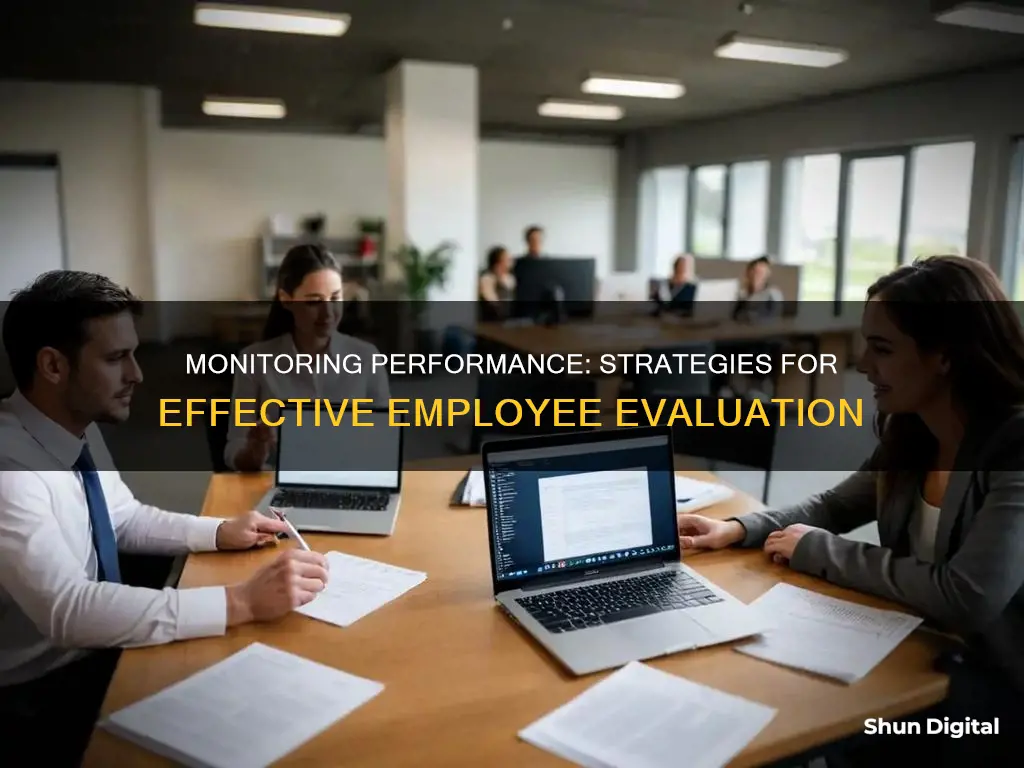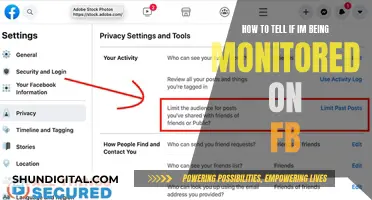
Monitoring employee performance is a crucial aspect of management. It can be a delicate balance between supporting and checking in on employees without infringing on their privacy or hovering over their every move. There are several effective strategies for monitoring employee performance, including regular check-ins, one-on-one meetings, performance management software, self-monitoring tools, peer reviews, and feedback. These techniques help managers stay informed about employee progress, address issues, and provide guidance to improve productivity and satisfaction.
| Characteristics | Values |
|---|---|
| Regular check-ins | One-on-one meetings, project check-ins, individual employee check-ins |
| Visual monitoring | Direct observation, shadowing, walking the floor |
| Time tracking | Time tracking software, time tracking applications |
| Self-monitoring | Self-monitoring tools, project plans, checklists, activity logs |
| Task management | Task management software, project management tool |
| Performance management software | Performance management software, employee monitoring software |
| Peer reviews and feedback | 360-degree feedback, peer reviews, self-reported surveys |
| Incentives | Rewards, raises, promotions, bonuses |
| Data-driven decisions | KPIs, quality of work, productivity, goals achieved |
| Recognition | Appreciation, sharing praise from clients/customers, gifts cards, paid trips |
What You'll Learn

Regular check-ins and one-on-one meetings
Check-ins are typically weekly one-on-one meetings between managers and employees to discuss progress on projects and assigned tasks. They are an opportunity for managers to assess whether their direct reports are on the right track and provide feedback if they are not. Check-ins can also be daily, depending on the team's needs and dynamics. Remote or distributed teams, for example, may benefit from more frequent check-ins to promote unity and keep everyone on the same page.
- Stick to the meeting agenda: This ensures the meeting stays focused and addresses all necessary points. It is important to ask the right check-in questions to cover everything pertinent.
- Set a list of action items: Clearly outlining action items gives employees clarity on what needs to be done and by when. It helps create benchmarks and track progress.
- Ensure your employees feel like the meeting was helpful: Ask for feedback from your employees to understand what was helpful and what could be improved in future meetings.
In addition to check-ins, individual employee check-ins are also important. These are more casual touchpoints to ask how the employee is doing and if they need any support. It is an opportunity for employees to reflect on their own work and discuss any issues they may be facing.
- What is their view of their performance?
- Do they think they can improve in certain areas?
- Is something in their personal life affecting their performance?
By combining regular check-ins and individual employee check-ins, managers can effectively monitor employee performance, provide support, and build strong working relationships.
Ankle Monitor Offenses: Understanding Criminal Triggers
You may want to see also

Performance management software
- Deel—Best for continuous performance feedback via 1:1 meetings. It offers a comprehensive platform that includes payroll, onboarding, offboarding, and document management. It also enables businesses to hire and manage employees and contractors internationally.
- Mitratech Trakstar—Best for connecting all stages of the employee lifecycle. It helps manage performance reviews, employee engagement surveys, 360-degree feedback, and goal setting. It has a user-friendly interface and customisable appraisal forms.
- Performance Pro—Best for performance evaluations of individual competencies. It offers detailed performance appraisals, 360-degree feedback collection tools, and merit-based bonus modelling.
- ClearCompany—Best for simplifying and automating HR workflows. It provides an easy way to automate performance reviews, with customisable scoring tables, weighted sections, and free-form responses.
- GoCo—Best for automating performance review cycles and feedback reminders. It offers integrated solutions for onboarding, benefits administration, time tracking, and document management. It includes dynamic performance review fields, 360-degree feedback tools, and automatic reminders.
- ThriveSparrow—Best for AI-powered performance insights. It provides 360-degree performance reviews, employee recognition tools, engagement surveys, and goal-setting features. It integrates with Slack, Microsoft Teams, Google Workspace, and other platforms.
- PerformYard—Best for customised performance review processes. It offers flexible features for HR and a simple employee experience, allowing for customisation to fit the organisation's needs.
- Primalogik—Best for collecting and analysing 360-degree feedback. It includes performance review assessments, engagement surveys, employee goals, instant feedback, and real-time performance tracking.
- Leapsome—Best for employee development-oriented performance management. It offers 360-reviews, employee engagement surveys, meeting management, and OKR (Objectives and Key Results) tracking. It integrates with various platforms such as Slack, Microsoft Teams, and calendar apps.
- Peoplebox—Best for linking OKRs and performance reviews. It helps streamline the performance review process, provides a centralised goal-setting dashboard, and offers integrations with tools like Asana, BambooHR, and Slack.
These software solutions can help improve the efficiency and effectiveness of the review process, providing structure and support for both managers and employees.
Battery Size for Elfi Doggy Monitor: All You Need to Know
You may want to see also

Self-monitoring tools
Project Plans
Project plans allow employees to visualise the steps they need to take to reach their goals and monitor their progress. They can also help employees to stay organised and ensure they are on track to meet deadlines.
Checklists
Checklists are a simple but effective way to ensure employees are meeting expectations. They can be used to create a clear list of tasks that need to be completed and can be used to create a sense of achievement as tasks are ticked off.
Activity Logs
Activity logs are diaries that employees keep throughout the day, noting exactly what they do, including breaks and interruptions. Each time an employee moves on to a new activity, they note the time and the new task they are turning to. This can help employees to stay focused and ensure they are allocating their time effectively. It also provides an accurate record of their activities, which can be useful for managers when reviewing performance.
Application Performance Monitoring (APM)
APM tools are useful for monitoring the performance of applications and software. They can provide insights into CPU utilisation, memory demands, disk I/O speeds, application response times, and error rates. APM tools can be used to monitor applications across on-premises, cloud-based, and hybrid environments.
Some examples of APM tools include:
- AppDynamics
- Datadog
- Dynatrace
- Instana
- Loupe
- ManageEngine Applications Manager
- New Relic
- Raygun APM
- Scout APM
- Site24x7 APM Insight
- SolarWinds AppOptics
- Stackify Retrace
IPS Monitors and LCDs: What's the Difference?
You may want to see also

Task management software
When choosing a task management software, it is important to consider the specific needs and requirements of your team. Some software may be more suitable for remote teams, while others may offer more advanced features such as workflow automation or customizable reminders.
- Monday.com: Offers marketing and PMO teams specific task management features, such as brand asset management, robust Gantt charts, and campaign tracking.
- Trello: A simple and easy-to-use option, perfect for managing linear tasks on a smaller scale. It utilizes a drag-and-drop Kanban board system and offers basic task management features such as task prioritization and due date assignment.
- Asana: A collaborative task management tool ideal for remote teams. It offers pre-built templates, centralized communication features, and the ability to add and track cross-team tasks.
- ClickUp: AI-enabled task management software that supports task prioritization, progress monitoring, and workflow optimization. It integrates with commonly used apps such as Slack, Gmail, and Zoom.
- Hive: Facilitates team collaboration by providing a shared platform for task assignment, tracking, and execution. It includes features such as group discussions, task status tracking, and a no-code task automation tool.
- SmartTask: Effective for managing multiple projects simultaneously and includes features such as task deadlines, dependencies, and recurring tasks. It also offers internal and external team communication capabilities.
When utilizing task management software, it is important to set clear goals and expectations for your team, regularly review work-in-progress, and provide feedback to optimize performance and productivity.
Removing Polarization Filters: Monitor Maintenance Guide
You may want to see also

360-degree feedback
The process typically involves eight to twelve people filling out an anonymous online form with questions covering a broad range of workplace competencies. The questionnaire includes rating scales and space for written comments. The person being evaluated also fills out a self-rating questionnaire with the same questions. The results are automatically tabulated and presented in a format that helps the recipient create a development plan to improve their skills.
The benefits of 360-degree feedback include providing a comprehensive, holistic view of an employee's performance, improving self-awareness, promoting accountability, and helping employees develop their leadership skills. It can also be used to identify areas for improvement and address challenges related to teamwork, character, communication, and leadership effectiveness.
However, there are some challenges and criticisms associated with 360-degree feedback. It can be time-consuming and politically charged, and there may be concerns about the subjectivity and fairness of the feedback. Additionally, employee manipulation of feedback ratings has been reported in some companies. To mitigate these issues, it is important to establish trust between raters and ratees, preserve anonymity, and provide training to reduce individual bias.
Overall, 360-degree feedback is a valuable tool for monitoring employee performance and can provide valuable insights to improve individual and organizational performance.
Is Your Monitor Glossy? Here's How to Tell
You may want to see also
Frequently asked questions
It's important to find a balance between monitoring and supporting your employees. You can do this by scheduling regular check-ins and one-on-one meetings with your team. This will help you stay updated on their progress and hold them accountable, without hovering over their every move.
When working remotely, you can use performance management software to streamline the monitoring process. These tools help set goals, track progress, and provide data to back up decisions. You can also pay close attention to conference calls and messaging channels to get a sense of how your employees are performing.
You can arrange 1:1 meetings with each employee to discuss their progress and any concerns they may have. This will give you an idea of how they are performing and help you address any issues proactively. You can also use self-monitoring tools, such as time-tracking software, to help employees track their own performance.
To monitor your team's performance, you should set relevant goals and establish milestones to help your team stay on track. You should also track key performance indicators (KPIs) such as quality of work, productivity, and goals achieved. Leverage technology and monitoring software to automate tasks and acquire accurate data on your team's performance.







